|
Dear Sir or Madam,
Today we would like to inform you about newly published FOSTA final reports from the fields of mobility, construction as well as plant and mechanical engineering.
These and all other FOSTA reports can be found at shop.stahldaten.de
We would like to wish you now an interesting reading.
Your FOSTA team
| P 1128 – Thermal joining of arc structured steel with fiber reinforced plastics (IGF-No 19042 BR)
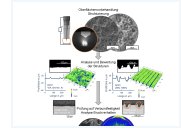
In order to make full use of the lightweight construction potential of steel, adapted joining processes have to be developed, whereby the joining of steel with fibre reinforced plastics is of particular interest. So far, mainly mechanical joining and bonding have been used.
Thermal joining, however, offers clear advantages over these methods. In order to be able to use it with sufficient adhesive strength, the adhesion between metal and plastic need to be ensured reproducibly. This requires a suitable temperature-time control of the process as well as a suitable roughening of the metallic joining surface. Within the scope of this project, the joining temperature is adjusted over time by means of a laser and the surface texturing is produced by means of an anodically poled TIG process. The achievable adhesion values are investigated and compared with reference samples, which were structured by laser. more information
|
| P 1123 – Hollow section frameworks with adhesively bonded brace (IGF-No 18969 N)

Foundation structures of offshore wind turbines for water depths of more than 20 m are often designed as jacket framework structures. Up to now, the individual hollow sections of these truss constructions have been joined by welding. Due to the spatial intersection of the tubular profiles at the junctions and the resulting complex weld seam geometries as well as the large open areas required for final assembly, this represents a major production effort. An innovative hybrid connection of the bracings to the legs of these supporting structures is the focus of this research project. The concept combines the joining processes of adhesive bonding, welding and screwing by the formation of node shells at the ends of the bracings. more information
|
| P 1114 – Feasibility and geometry prediction of sheet metal components with sheet metal extrusions made of high- and ultra-high-strength steels (IGF-No 18625 N)
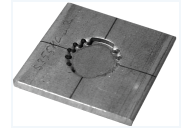
The reduction of manufacturing costs is a primary aim for increasing the competitiveness of producing companies. In this context, embossing, also referred to as offsetting or sheet metal extrusion, shows great potential as it offers the possibility to create functional surfaces within a single manufacturing step and without any post-processing.
In DIN 8587, embossing is defined as a shear-forming process, in which one part of a work-piece is displaced relative to another with a linear tool motion. The plastic deformation is mainly caused by a state of shear stress, equivalent to fine blanking or blanking with a small die clearance. Similarly, the technology and tool kinematics are alike in these processes. This leads to the conclusion that embossing resembles a shear cutting process, though without completely cutting through the work-piece. more information
|
| P 1097 – Development of an integrated floor slab system for steel and composite construction (IGF-No 18658 N)
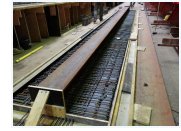
The goal of this research project is to develop an integrated floor slab system in steel and composite construction ready for practical application in a demonstrator stage as well as the derivation of engineering models for the description of its structural behavior. The starting point of this research project is the floor slab system InaDeck which was conceived within the framework of the FOSTA research project P 879. This floor slab system is characterized by large spans and integrated building services. In order to lead this integrated floor slab to practical suitability on the one hand the floor slab elements need to be optimized with regard to their structural behavior, their economic efficiency and their resource utilization (rolled sections and shear connectors), on the other hand the integration of the slab system into the overall supporting structure of the building has to be developed. more information
|
| P 680 – Determination of damage mechanisms in stainless steel bondings as a contribution to production safety and reliability (IGF-No 14704 N)
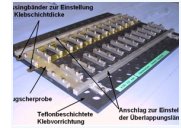
The aim of the project was to determine the damage mechanisms in stainless steel adhesives as a contribution to production safety and reliability. It thus directly follows on from the topic of the previous project “Bondability of stainless steel in automotive engineering”. The focus was on the investigation of the ageing resistance of bonds made of stainless steels with hot-curing epoxy resin adhesives (dicyandiamide as hardener) and on the differentiation of influencing variables on the ageing progress. For the investigation of the stochastically occurring, local adhesive failure of stainless steel adhesives, a new experimental scheme developed. In case of locally occurring changes in the adhesive strength of individual tensile shear test specimens, it enables the substrates to be assigned to the exact removal position (board number and position on the board). In the case of a deviating mechanical behaviour of individual test specimens, the surrounding areas can thus be made accessible to specific surface-analytical measurements to clarify the cause. more information
|
| P 1234 – Shell structures made of curved sandwich panels (IGF-No 19519 N)
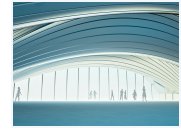
As expected, the research project confirmed that the manufacturing effort for curved sandwich panels is higher than for those with a flat surface. The strategy of range limiting of the possible geometric variations in favour of better manufacturing conditions on the one hand and maximizing them on the other hand by design-specific optimisation was successful. Using the developed design tool for curved sandwich elements, the unrestricted design flexibility in the development of sophisticated building geometries can be ensured and contemporaneously an undesirable and immense manufacturing complexity of curved sandwich panels can be limited. The planner is provided with meaningful design corridors at an early design stage, within which later production will be economically possible. This combination of planning and production ensures the desired research success. more information
|
| P 770 – Development of a process chain for the production of partially reinforced sheet metal structures using novel basic adhesives and adapted processing techniques (IGF-No 15638 N)
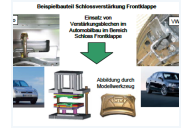
In this “Process Chain” project, basic adhesives (= preliminary stage to commercially usable adhesives) were developed for the first time, which enable the process steps of adhesive application and joining, which were previously carried out in a strict sequence, to be separated in principle. This is achieved by the fact that the basic adhesives have two different curing mechanisms. After passing through the first curing step, a dry, nontacky adhesive layer is present, which is still reactive. After joining with a second component, the pre-applied adhesive layer is melted by heating, thus activating the adhesive. Subsequently, the adhesive finally reacts to form a duromer. This new principle can be used in many ways. more information
|
| P 1043 – Optimized dimensioning of wind turbines with high lattice towers under realistic consideration of aerodynamic impact, fatigue behavior and choice of steel grades (IGF-Nr. 18662 N)
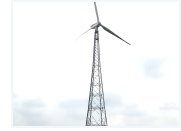
This research project examined a number of fundamental aspects of the economics and technical superiority of tall lattice towers with and without wind turbines. The worked focused on both the aerodynamic properties of lattice towers and the structural aspects of the design. With regard to the latter, the topology (that is the geometric arrangement of the beam elements), the influence of the cross-sectional design and the steel grades, which were varied as part of an optimization process under costeffectiveness criteria, were particularly relevant. more information
|
|
|
|









